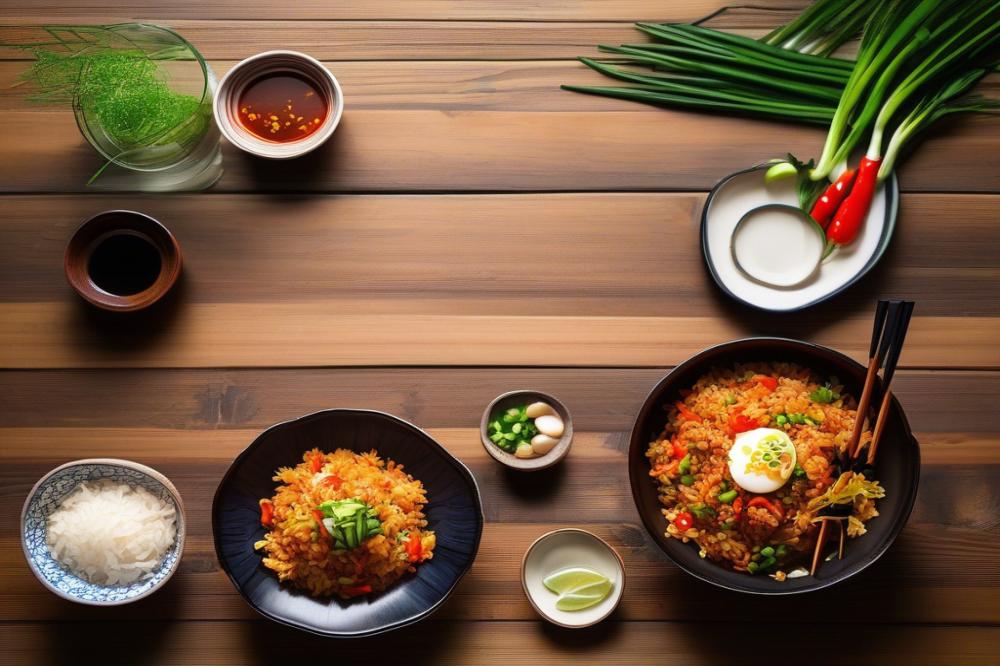Understanding Kimchi Bokkeum Fried Rice
Kimchi Bokkeum Fried Rice is a beloved dish in Korean cuisine. It stands out as a staple comfort food that brings warmth to everyday meals. The blend of spicy kimchi with fried rice creates a delightful flavor experience. This dish also offers a fantastic way to use leftover rice, making it both practical and delicious.
Using authentic ingredients when preparing Kimchi Bokkeum Fried Rice is crucial for achieving the right taste. Quality kimchi enhances the dish’s flavor, providing the necessary spice and tang. Many people enjoy adding different vegetables to the mix, like carrots or peas, to boost color and nutrition. By incorporating high-quality soy sauce or sesame oil, the dish gains depth and richness. Exploring these flavors can elevate a simple Fried Rice Recipe into something truly special.
This meal holds a unique place in many hearts. It’s not just food; it embodies nostalgia and comfort. The satisfaction of a hot bowl of fried rice brings joy. Quick meals like this one fit perfectly into busy lifestyles, allowing families to enjoy a homemade feast without a lengthy preparation. There is something undeniably appealing about the ease of this recipe, making it a go-to for both novice cooks and seasoned pros. In summary, Kimchi Bokkeum Fried Rice encapsulates the essence of heartwarming Korean cuisine. It is tasty, fulfilling, and ready in no time.
What is Kimchi Bokkeum Fried Rice?
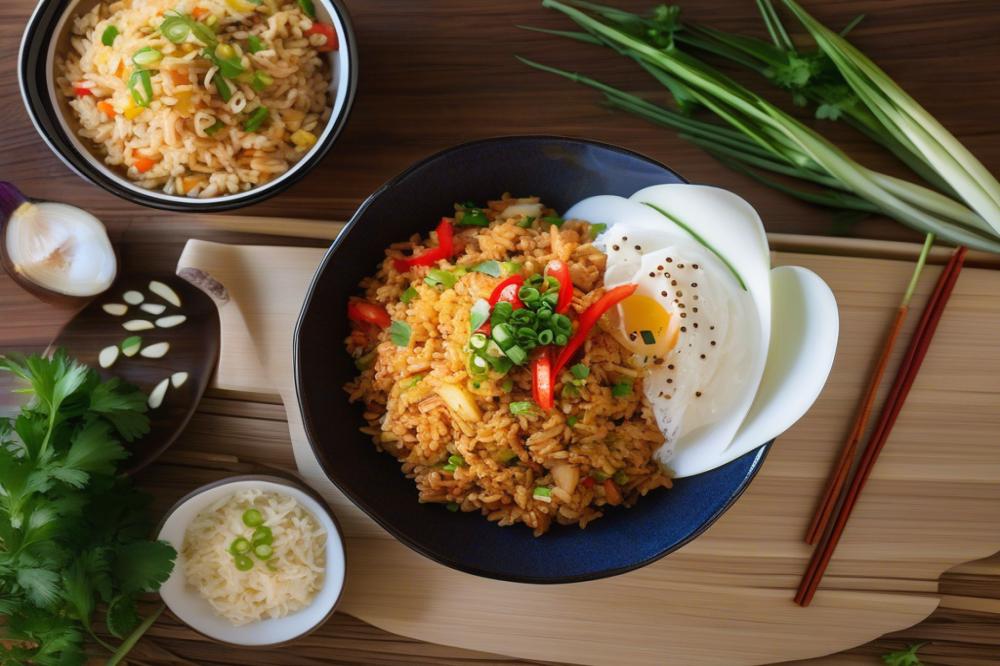
Kimchi Bokkeum Fried Rice is a popular dish in Korean cuisine. This dish combines key components that make it a delight for the taste buds. First, there is kimchi, a fermented vegetable dish. It usually consists of cabbage and radishes, mixed with spices. This spicy mix gives the rice its bold flavor. Next, the term “bokkeum” means “stir-fried” in Korean. This highlights the method of cooking involved in making this dish. Finally, fried rice refers to the use of cooked rice that is stir-fried. Various ingredients can be added to enhance the flavor.
A rich background supports this dish in Korean culture. Fried rice has been adapted by many, but Kimchi Bokkeum Fried Rice holds a special place. It’s a staple comfort food, often enjoyed as a quick meal. Families often make it after a big feast, using leftover rice and kimchi. The combination is satisfying and filling. Many find it an easy recipe with lots of variations!
Variations of the dish are numerous. Different vegetables can be added to suit personal tastes. Common choices include carrots, peas, and green onions. Some people like to mix in proteins, such as chicken, beef, or tofu. Eggs are often scrambled in for additional flavor and richness. This versatility means it can accommodate different diets and preferences. Street food vendors often customize it, adding ingredients like cheese or hot sauce for an extra kick. All these options ensure that each person can enjoy a unique version of Kimchi Bokkeum Fried Rice no matter where they are.
Ingredients List and Cooking Instructions
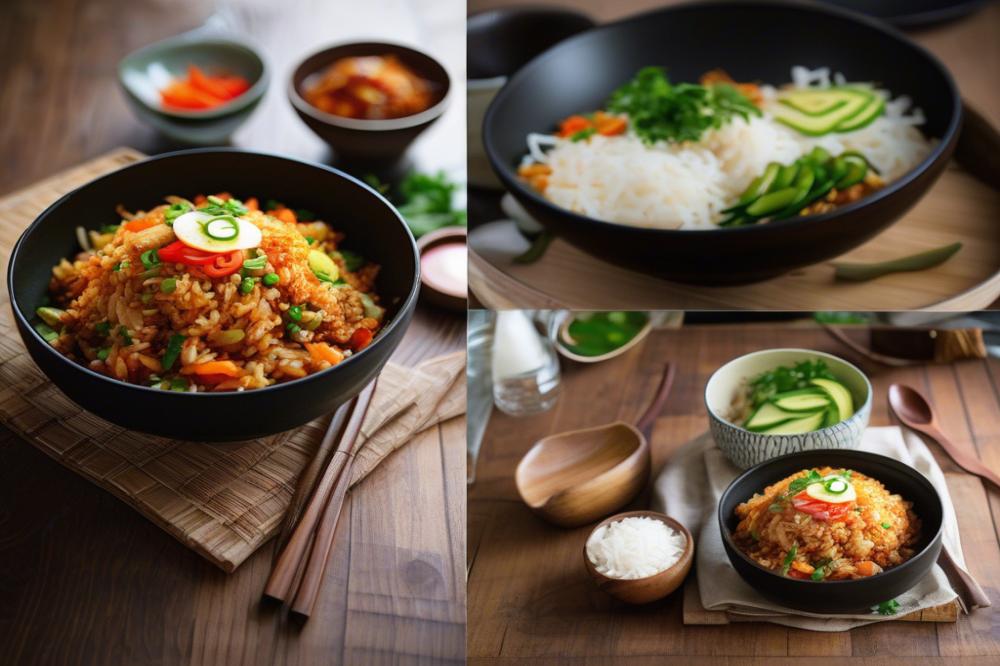
Ingredients List
- 2 cups cooked rice (preferably day-old)
- 1 cup Napa cabbage kimchi (chopped)
- 1/2 cup diced vegetables (carrots, peas, bell peppers)
- 1/2 onion (chopped)
- 2 cloves garlic (minced)
- 2 tablespoons vegetable oil
- 1 tablespoon gochujang (Korean red chili paste)
- 1 tablespoon soy sauce
- Salt and pepper to taste
- 2 green onions (chopped for garnish)
- Optional: fried egg on top
Cooking Instructions
First, heat the oil in a large pan over medium heat. Use vegetable oil for a neutral flavor. Next, add onions and garlic. Sauté these until the onions become translucent.
Once the onions are ready, it’s time to add the chopped kimchi, along with your diced vegetables. This combination gives the dish a spicy kick and adds color. Stir the mixture well, letting the flavors combine for about 2-3 minutes.
Now, incorporate the cooked rice into the pan. Break up any clumps, and mix everything evenly. This step is important for even flavor distribution. Pour in the gochujang and soy sauce. Stir everything together, ensuring each grain of rice is coated with the sauce.
Cook the fried rice until it’s heated through. This should take about 5 minutes. Stir frequently to prevent sticking. Season with salt and pepper to taste. If you like it spicier, you can add more gochujang at this stage.
As a finishing touch, chop the green onions and sprinkle them over the dish before serving. If desired, place a fried egg on top for added richness. This fried rice not only makes a quick meal but also showcases the heart of Korean cuisine.
Nutritional Information for Each Ingredient
- Cooked Rice: Contains carbohydrates, providing energy.
- Napa Cabbage Kimchi: Offers probiotics, which are good for digestion, and vitamin C.
- Diced Vegetables: Adds vitamins like A and C, along with fiber.
- Onion: Rich in antioxidants and can help reduce inflammation.
- Garlic: Known for its health benefits, including boosting the immune system.
- Vegetable Oil: Provides fat for cooking; choose a healthy option, like canola or olive oil.
- Gochujang: Contains capsaicin, which can boost metabolism.
- Soy Sauce: Adds flavor but watch for sodium content.
- Salt and Pepper: Basic seasonings that enhance all the flavors.
- Green Onions: Low in calories and adds a fresh taste.
- Fried Egg: Adds protein and healthy fats if included.
Cooking Tips for Authentic Flavor
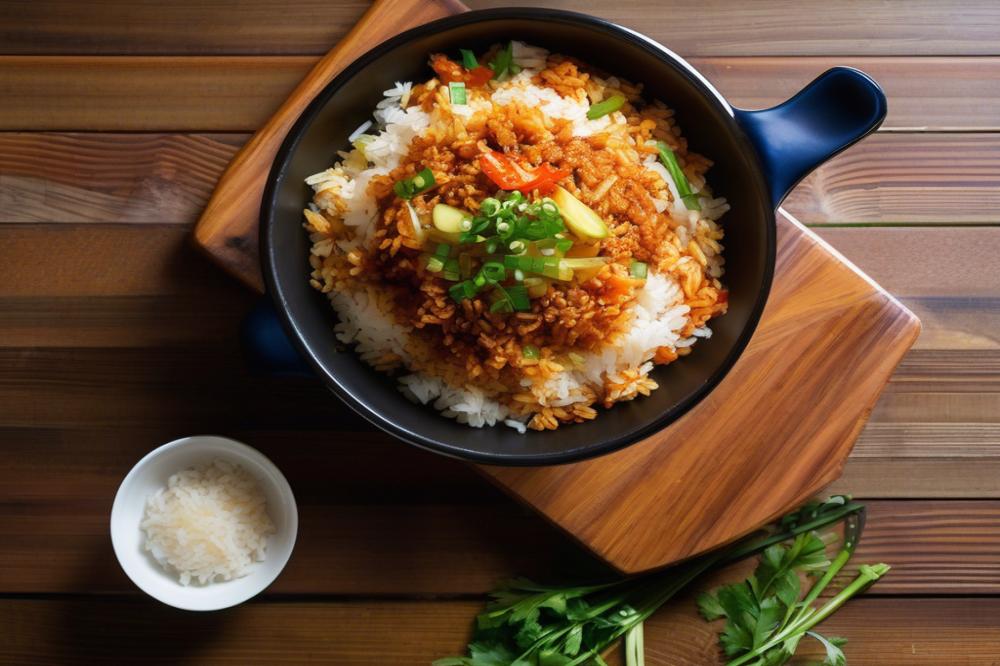
Using day-old rice plays a crucial role in achieving the right texture for your dish. Freshly cooked rice tends to be sticky and clumps together. Instead, cold rice created a firmer bite and helps prevent a mushy result. Refrigerate your leftover rice overnight for the best outcome.
Spice levels can vary greatly in Korean cuisine. Adjust the heat of your dish with gochujang, a staple in many Korean recipes. This fermented chili paste adds depth and a distinctive kick. If you prefer milder flavors, start with a small amount and increase it gradually to suit your palate.
The quality of kimchi significantly affects the overall taste. A well-fermented kimchi will lend its rich, tangy flavor to the fried rice. Look for authentic varieties, which often contain a mix of vegetables and spices. They will add not just zest but also complexity.
Protein options provide a nice boost to your meal. Tofu serves as a fantastic vegetarian choice, soaking up flavors beautifully. If you’re leaning towards meat, pork can work wonderfully, providing a savory element. Consider using bacon or diced pork belly for added richness.
Finally, don’t forget to include vegetables. Chopped carrots, peas, or green onions add both color and nutrition. These ingredients not only contribute to the dish’s overall appeal but also enhance its health benefits. Mixing in these elements keeps your Kimchi Bokkeum Fried Rice balanced.
Health Benefits of Kimchi Bokkeum Fried Rice
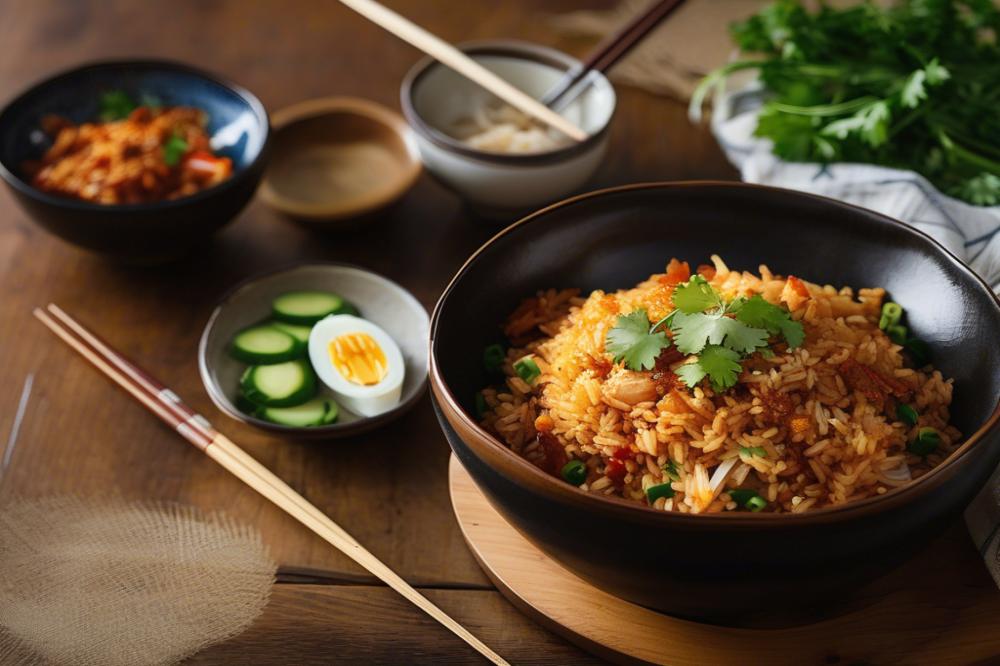
This dish offers a remarkable blend of flavors and health perks. The primary ingredients contribute to its nutritional value. Kimchi provides probiotics, while rice adds energy through carbohydrates. Eggs, often included, give a good source of protein. Fresh vegetables enhance the meal with vitamins and minerals, making it a balanced choice.
Nutritional Profile of Ingredients
Every component in Kimchi Bokkeum Fried Rice plays a role in nutrition. The rice serves as a great source of carbohydrates. It fuels the body for daily activities. Kimchi, made from fermented vegetables, contains healthy bacteria. This adds to digestive health and helps maintain a healthy gut. Moreover, colorful vegetables like carrots and peas are packed with essential nutrients.
Benefits of Fermented Kimchi
Fermented foods are known for their positive effects on health. Kimchi stands out due to its rich probiotic content. These beneficial bacteria improve gut health and boost the immune system. Eating fermented kimchi may also aid in digestion and help manage weight. Additionally, it contains vitamins A, B, and C, which are vital for overall wellness.
Balance of Carbohydrates, Proteins, and Vitamins
This fried rice dish harmonizes different food groups. The carbs from rice provide sustained energy, ideal for busy individuals. Proteins from eggs and any added meat support muscle repair and growth. Including a variety of vegetables ensures all essential vitamins are present. This balance makes it not just a meal but a nourishing option for quick meals or comfort food.
Serving Suggestions and Pairings
Recommended Side Dishes
When enjoying Kimchi Bokkeum Fried Rice, side dishes play a significant role. Serve it with a fresh cucumber salad. This adds a crunchy texture and balances the rich, spicy flavors. Consider pickled radishes as well, which provide a nice tang. Another option is a small bowl of steamed dumplings. They pair well and offer another layer of taste. For something lighter, opt for a simple miso soup. It complements the meal with warmth and umami.
Best Beverages to Accompany the Meal
For beverages, several choices enhance this experience. Traditional Korean drinks work wonderfully. Try barley tea, also known as boricha. Its nutty flavor contrasts nicely with spicy dishes. Alternatively, serve cold mineral water for a refreshing cleanse between bites. If you’re feeling adventurous, a light Korean beer could be ideal. It helps cut through the heat of the spicy fried rice. Soft drinks like ginger ale also provide a sweet balance.
How to Plate for Presentation
Plating can elevate the dining experience significantly. Begin with a clean white plate to make the colors pop. Use a ring mold to shape the fried rice neatly. This technique creates a stunning look on the table. Garnish with a sprinkle of sesame seeds for a lovely finish. Adding sliced green onions brings a fresh touch and bright color. To complete the look, serve with a side of kimchi in a small bowl. Proper presentation showcases the dish, making it appealing and inviting.
Final Thoughts on Creating Kimchi Bokkeum Fried Rice
Throughout this article, we have highlighted the simplicity and rich flavors of a beloved dish. Kimchi Bokkeum Fried Rice stands out for its ease of preparation and delightful taste. With just a few ingredients, you can transform leftover rice into a delicious meal. The tangy notes of kimchi blend perfectly with the savory depth of fried rice, making each bite satisfying.
Don’t hesitate to try making this dish at home. Experiment with different vegetables or protein options to cater to your taste. It’s a versatile recipe that anyone can enjoy, even if they’re new to cooking. Start with the basics, and you may find yourself adding personal twists as you gain confidence in the kitchen.
Exploring Korean cuisine is a rewarding journey. Many dishes are simple to make and delicious. If you enjoyed this recipe, consider checking out more easy options. You might discover new favorites that will continue to impress your friends and family. Happy cooking!

